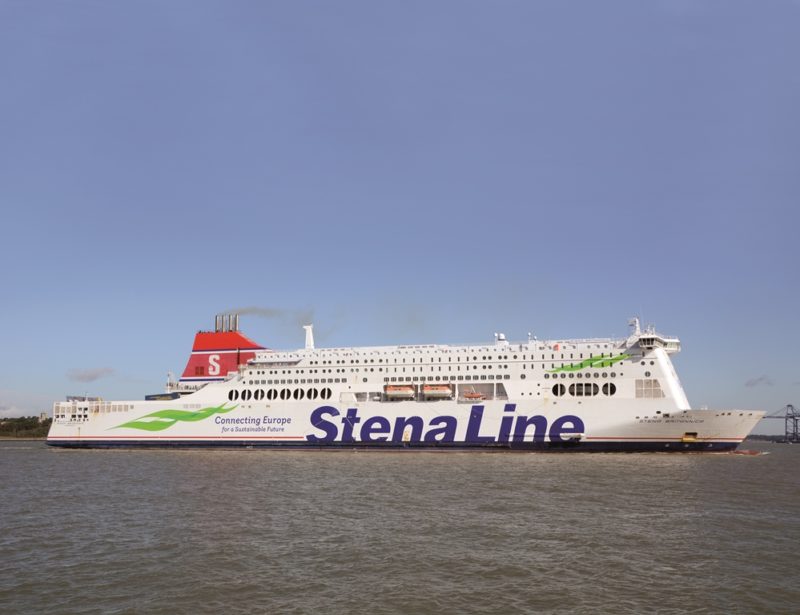
Sten Allan Olsson (1916-2013), founder of Stena, was one of the greatest Swedish maritime entrepreneurs and shipowners, along with Dan Brostrom (1870-1925) of the large Brostrom Group of Gothenburg, and Sven Salen (1890-1969) of the equally big Salen Group of Sweden. Sten Allan Olsson was born on 28th October 1916 on the small island of Donso in the Gothenburg archipelago as the son of Gustav Olsson, the owner of a small trading schooner. He was educated at Ljungskile Folk High School, followed by a commercial course at a college in Gothenburg. Sten learnt the entrepreneurial basics from his father of hard work, close long term family links, responsibility, thrift, and the transport, buying and selling of goods and services at very good profits. The charter market was very important for Sten, with classes of ro-paxes and freight ro-ros specifically ordered for charter to worldwide clients, and this was extended later into the purchase and chartering out of older second-hand ferries for use as accommodation ships for North Sea oil workers or for workers on industrial projects in remote Scandinavian locations where large hotels were not available. The many classes of new ro-paxes and ro-ros on the main routes from Sweden, Denmark, Germany or Northern Europe made Stena into the largest ferry line in the world.
On 18th November 1939, Sten Allan Olsson founded his Metallproducter trading business in Gothenburg, consisting of a large scrap steel yard and supervised from a two storey metal clad office. The yard was located behind one of the great shipbuilding yards in Gothenburg harbour, and scrap steel, boilers and rubber products were in great demand from his fledgling business for the shipyard during World War II. In 1946, he purchased his first ship with a loan of 25,000 Swedish kronor from the Handelsbanken. This was a three masted schooner named Dan after one of his three sons, Dan, Stefan and Christofer, born after his marriage to Birgit Andersson in 1944. The schooner was traded in the scrap metal, timber and general cargo trades of the Baltic. She was the first of a dozen owned small motor coasters and a dozen similar chartered coasters, that formed the Olsson fleet during the 1950s. The coaster Stefan of 497 grt, built in 1955 by the Solvesborgs Varv yard in Southern Sweden was the first newbuilding in the fleet, and had a very long career after her sale by Sten, and was still afloat 45 years later in Greece as Santa Maria. The Metallproducter business in 1952 opened a separate branch for metal collection and processing at Hisingen near Gothenburg, which is still in business to this day as a major recycling company.
Sten Allan Olsson moved into the passenger transport trades in December 1962, when a chartered small passenger ship set sail from Gothenburg to Skagen in Denmark. This was the chartered Bornholm ferry Ostersoen, but the ice was too thick on the Kattegat during the winter and this charter was quickly ended. In the Spring of 1963, he took over the Skagen Line passenger service on the same route with the small twin decked steamer Brynhild of 937 grt, built in 1914 as Heimdal by Burmeister & Wain at Copenhagen also for service to the island of Bornholm from the mainland. She was of overall length 209.6 feet, moulded beam of 34.2 feet, and moulded depth of 18.6 feet, and could carry 350 passengers at a service speed of 12 knots from a triple expansion steam engine by her builders for island service. She was renamed as Skagen I, and was then purchased in 1964. The running mate of Skagen Line was a former Gotland island steamer built in 1924 by the Oskarshamns yard as the twin decked Visby for Rederi A/B Gotland, renamed Skagen II of 799 grt and overall length 171.2 feet, moulded beam of 30.5 feet, moulded depth of 13.7 feet with a service speed of 12 knots from a triple expansion steam engine by her builders.

Skagen I was used in the 1964 summer season for a service from Lysekil to Skagen and then sold in 1965 and converted into a barge. Skagen II continued the successful, rapidly expanding Kattegat service until broken up in 1968, along with chartered excursion passenger ships such as Wappen von Hamburg, which was also purchased, Seute Deern, Seebad Warnemunde, Hein Goden-wind and Helgoland of 2,855 grt, built by the Howaldtswerke yard in Hamburg in 1963, from German owners. Helgoland served as a hospital ship in Vietnam between 1966 and 1972 and was then purchased by Stena and renamed Stena Finlandica. She was sold in 1975 and renamed Baltic Star, and started a new career in 2001 as Galapagos Legend.
Much publicity was gained from the visit of President Nikita Khrushchev, Soviet Union leader from 1953 to 1964, to Gothenburg in 1964 to visit the big Arendal shipyard in the harbour as well as a tour of the city. He travelled around the harbour on the newly completed Stena passenger vessel Poseidon of 1,364 grt from the Ulstein Mek Verksted yard in Norway. She was also to take President Khrushchev and his family on a cruise from Uddevalla to Gothenburg, but this did not happen. Poseidon was yard number 26U with accommodation for 600 passengers with a service speed of 16.25 knots from a Deutz diesel engine of 2,640 bhp. She had an overall length of 65.5 metres and a moulded beam of 11.6 metres, and left the fleet in 1972 on charter to Brittany Ferries for the Plymouth to Roscoff route. After a long career of 42 years, she was broken up in India in 2006. A similar newbuilding passenger ship to Poseidon was also completed as Afrodite at a yard in Elmshorn in 1964.
The sisters Stena Danica and Stena Nordica of 2,607 grt were completed in 1965 by the Le Trait yard of Ateliers et Chantiers de la Seine Maritime as the first purpose built Stena car ferries. They had large funnels and were twin screw motor vessels fitted with Klockner Humboldt Deutz diesel engines to give service speeds of 17.5 knots. They could accommodate one thousand passengers with 129 cars and 14 lorries on their vehicle decks. After Stena Danica joined the Gothenburg to Frederikshavn route in June 1965, a different strategy was used for Stena Nordica for a new summer passenger and car Tilbury to Calais service as ‘The Londoner’. She was displayed to the British press in July 1965 on the Thames with ‘THE LONDONER’ in red capitals on both sides of her hull. She was then chartered for the 1966 season for the Stranraer to Northern Ireland service of the Caledonian Steam Packet Company, with a chartered vessel, Prinsessan Christina, on ‘The Londoner’ service in 1966, and the new smaller twin funnelled Stena Baltica of 1,200 grt from the Langesunds yard in Norway in 1966 and used in the last 1967 season of ‘The Londoner’. Stena Baltica was sold in 1970, Stena Danica was sold in 1969, and were replaced by the sisters Stena Germanica and Stena Britannica of 5,195 grt from the Langesunds yard for a new Gothenburg to Kiel service. Insufficient traffic forced Stena Britannica on to the Gothenburg to Frederikshavn for a few months until her sale to the Alaska Marine Highway to run as Wickersham in 1968.
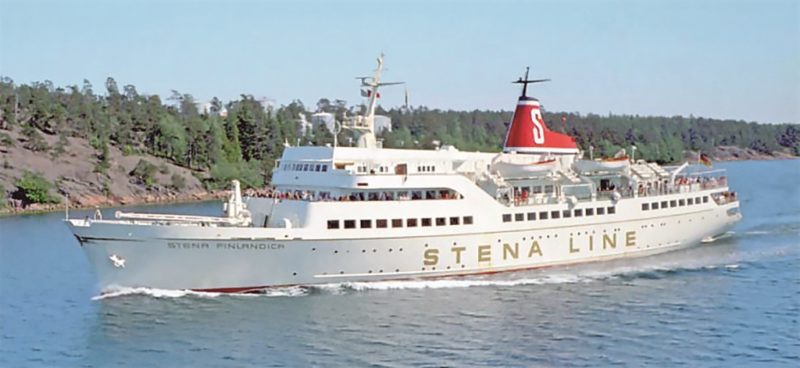
EXPANSION by DIVISION
The Olsson twin businesses of metal recycling and passenger ferry transport were divided into two branches in 1972, named Stena Metall A/B and Stena Line A/B respectively, and a new much larger Stena Line passenger ferry terminal was completed that year in Gothenburg as the Masthugg Terminal. The passenger facilities at Skagen and nearby Frederikshavn in Denmark remained very basic until later rebuilt. The Stena Line A/B ferry fleet consisted of thirteen ro-pax and ro-ro ships at that time, with four new ro-pax ferries under construction at the Trogir and Kraljevica yards in Jugoslavia as Stena Jutlandica, Stena Nordica, Stena Olympica and Stena Scandinavica. Two were used as overnight ferries on the Gothenburg to Kiel route and two as day ferries on the Gothenburg to Frederikshavn route, with Stena Olympica named in honour of the 1972 Olympic Games at Munich. Stena Nordica was renamed Stena Danica (3) shortly after completion in 1974, with Stena Danica (2), completed by the A. G. Weser yard at Bremerhaven in 1969, sold after only five years of service to BC Ferries of Canada in April 1974.
The overnight capacity on the service from Gothenburg to Kiel was boosted during the period 1971 to 1973 by the purchase from Swedish Lloyd of their Saga built in 1966 and renamed Stena Atlantica. A quartet of new passenger and freight ro-ros entered service in 1974/75 from the Rickmers Werft yard in Bremerhaven as Stena Normandica, Stena Nautica, Stena Nordica and Marine Atlantica, the latter completed for charter to Marine Atlantic in Canada. They had two vehicle decks with head room to carry trucks as well as cars, and accommodation for 1,084 passengers. Stena Normandica was sold to Sealink in 1985 and renamed St. Brendan for the Fishguard to Rosslare service. Stena Nautica joined her sister on charter to Marine Atlantic of Canada as Marine Nautica, while Stena Nordica was several times chartered to Soutos-Hellas Ferries of Greece. Swedish Lloyd withdrew their remaining ferry Patricia in 1977, and she was purchased by Stena Line and sent to the Tees to increase the head room on her decks to take freight trucks as well as cars, and sponsons were added to her hull to give extra stability and safety for an larger passenger accommodation. She inaugurated a new Stena Line route from Frederikshavn to Oslo as Stena Saga in 1979, sailing northbound in daylight and returning to Frederikshavn at night.
Stena Line introduced in 1972 a computer based passenger travel reservation system, and followed this up six years later with a computer based reservation system for freight. The first Stena freight ro-ros in the fleet joined the fleet in 1970, with Stena Transporter (later Jarl Transporter of Marine Atlantic of Canada) as the first on the Gothenburg to Kiel route. The sisters were Stena Carrier, later renamed Ulidia on the Irish Sea services of British Rail, Stena Trailer of 1971 which became Dalriada on the Stranraer to Larne route, while other similar freight ro-ros of this initial smaller size included Stena Topper (later Darnia on Irish Sea routes), Stena Timer, Stena Seatrader, Stena Shipper, Stena Trailer, and Stena Sailer, the latter from the Vuyk & Zonen yard in Holland in 1973.
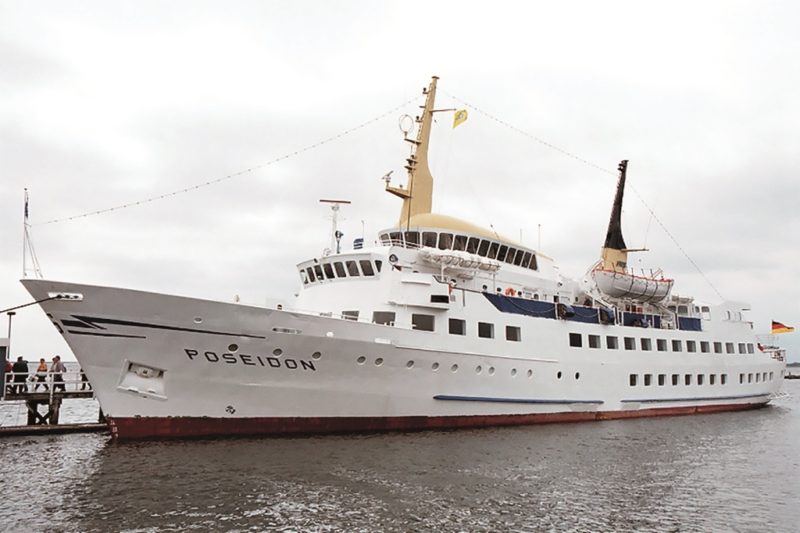
STENA SEARUNNER RO-RO CLASS
A major investment was made from early 1977 until late 1978 in a larger freight ro-ro class of eleven vessels, known as the important ‘Searunner’ class. The class was designed and built by the Hyundai Heavy Industries yard at Ulsan in South Korea as twin screw ships with a lane length of 1,650 metres of freight and a deadweight from 8,670 to 9,200 tonnes. They had dimensions of overall length of 155.6 metres, moulded beam of 21.7 metres, and a maximum loaded draft of 7.3 metres. There were overnight cabins for a dozen drivers, and two big powerful Pielstick four stroke diesel engines of 15,636 bhp gave a service speed of 18 knots via twin propellers. The blue hulled class had a crew of 30 and spent most of their long careers chartered out by Stena, and were built as Yard numbers 642 to 652 as follows:-
Y642 – Merzario Ausonia on charter to Merzario Lines, renamed in 1980 as Stena Freighter, later chartered out until arrived at Alang for breaking up on 29th September 2011.
Y643 – Stena Runner renamed in 1978 as Alpha Progress on charter to Greek owners, with a brief charter to Tor Line in 1979, converted to a Ro-pax in 1979 at Bremerhaven with later charters to Hellas Ferries as Hellas, until purchased by Townsend Thoresen European Ferries and renamed Doric Ferry for Felixstowe service. Renamed European Tideway in 1992 until repurchased by Stena and renamed Stena Transfer in December 2002 for Harwich to Europoort service. Arrived for breaking up at Alang on 10th March 2012.
Y644 – Norsky on charter to North Sea Ferries, renamed in 1980 as Stena Shipper and later chartered out until rebuilt at Hamburg in 1987, and in service until broken up at Aliaga in May 2010.
Y645 – Elk on charter to P. & O. Ferrymasters for a regular Tees to Gothenburg service with extra hull section inserted in 1987, until renamed Tor Baltica in 2001. Arrived at Alang on 24th November 2011 for breaking up.
Y646 – Stena Prosper but launched as Atlantic Prosper on an ACL charter, renamed Stena Ionia in 1981, Stena Gothica in 1985 and rebuilt at Bremerhaven in 1986. She became Finnbirch for Finnlines in 1997 and capsized and sank off the East coast of Sweden on 1st November 2006.
Y647 – Gate Felicia on charter until renamed Stena Grecia in 1983, and Atlantic Freighter in 1987 on charter to Marine Atlantic of Canada. She was sold to Greek owners in 2010 and renamed Pelagitis and is still in service.
Y648 – Stena Project but launched as Atlantic Project on charter to ACL, renamed Stena Hispania in 1983 and rebuilt at Bremerhaven in 1986. She was renamed Finnforest in 1996 for Finnlines and arrived for breaking up at Alang on 3rd September 2011.
Y649 – Alpha Enterprise on charter to Greek owners with a brief charter to North Sea Ferries in 1979 until converted into a Ro-pax at Bremerhaven in 1980, chartered to Hellas Ferries as Syria and then to Townsend Thoresen European Ferries for a Felixstowe to Europoort service. Renamed Stena Transporter in 1983 with short charters to TT-Saga Line and Cobelfret in 1984, followed by more charters out as Cerdic Ferry and European Freeway for Felixstowe to Rotterdam service. P. & O. Felixstowe services were sold to Stena in 2002 and she was renamed Stena Partner in 2002, and is still in service with new owners as Sea Partner.
Y650 – Imparca Express 1 on charter until renamed Stena Carrier in 1980 followed by more charters out until she arrived for breaking up at Aliaga on 7th June 2012.
Y651 – Merzario Hispania on charter to Merzario Lines until converted in 1981 to a Ro-pax at Bremerhaven for Townsend Thoresen European Ferries for a Felixstowe to Europoort service. Served in the Falklands War in May 1982 as Nordic Ferry, chartered out to P. & O. European Ferries until July 2002. Chartered to Scandlines for a Trelleborg to Travemunde service for much of 2002 and then returned to Harwich to Europoort service, renamed as Stena Transporter in 2002 until broken up at Aliaga during 2017.
Y652 – Stena Trader but completed in 1978 as Stena Transporter and converted in 1980 to a Ro-pax at Bremerhaven. Served in the Falklands War in May 1982 as Baltic Ferry, later long charters to P. & O. until she arrived at Alang for breaking up on 7th August 2011.
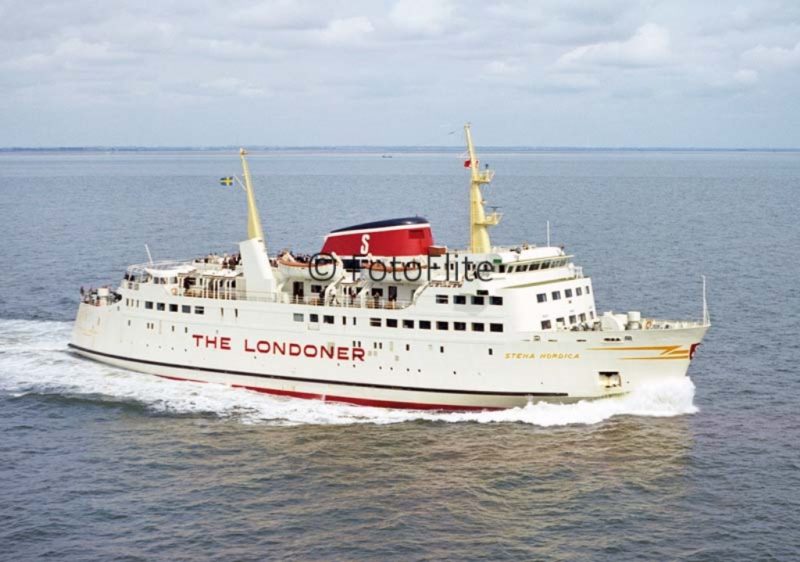
STENA EXPANSION INTO BULK, OFFSHORE and DRILLING SECTORS
Dan Sten Olsson, born in 1947 as the son of founder Sten Allan Olsson, became Managing Director of parent company Stena A/B of Gothenburg in 1983. Dan had a vision of a very large Northern European ferry giant, a vision that he pursued vigorously with many initiatives until he was ultimately very successful by the Millennium and onwards with a very large ferry empire that stretched from the Irish Sea to the North Sea and to all corners of the Baltic Sea. He chartered the handsome twin funnelled Fred. Olsen ferry Bolero of 11,344 grt, completed in 1973, in May 1978 from her Newcastle to Kristiansand, Stavanger and Bergen service for a four year charter. She replaced Stena Scandinavica, sold to Irish Continental Line to run as St. Killian. Bolero had also been designed for Caribbean cruising in winter, and under the name of Scandinavica continued this warm water cruising with Stena, replacing the liner Stockholm of 1948 vintage that had been used by Stena under charter for an annual cruise from 1966 as the East German Government owned Volkerfreundschaft.
Expansion into the petroleum sector began in 1976 with the first Offshore Supply Vessel, Oil Piper completed in 1976 in Norway, and in the fleet until 1981. Tanker owning and the oil trades began in 1982 with the formation of Stena Bulk A/B division of the company. The gas tanker Mandrill of 41,256 dwt had been purchased in 1980 and renamed Stena Oceanica. The VLCC tanker Santillana of 269,195 dwt was purchased in 1983 and renamed Stena Atlantica, the Aframax tanker Elvira C of 132,478 dwt was purchased in 1983 and renamed Stena Pacifica, and the product tankers Esso Nagoya of 22,075 dwt, and Afran Neptune of 31,185 dwt were also purchased in 1983 and renamed Stena Adriatica and Stena Caribica. Northern Marine Management was formed in 1983 to manage tankers that were not Swedish flagged, and the publicly quoted Concordia Maritime A/B was jointly formed with Neste of Finland and listed on the Stockholm Stock Exchange as the main tanker owning company.
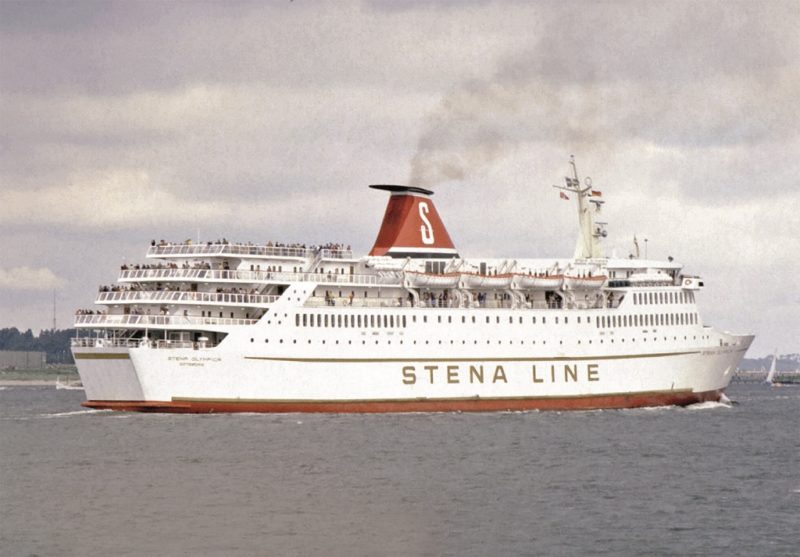
Universe Tankships (Delaware) Inc, a subsidiary of National Bulk Carriers of the U.S.A., was taken over in 1986. A fleet of fifteen tankers of 1.75 million deadweight tonnes had been built up by 1986. VLCCs of Universe Tankships (Delaware) Inc. and Burmah Tankers Inc. were renamed as follows:-
Stena Concordia ex Universe Burmah
Stena King ex Burmah Enterprise
Stena Queen ex Burmah Endeavour
Stena Concept ex Universe Monitor
Stena Congress ex Universe Mariner
Stena Constellation ex Universe Sentinel
Stena Contender ex Universe Ranger
Stena Continent ex Universe Guardian
Stena Convoy ex Universe Pioneer

Stena Explorer ex Universe Explorer
The new Aframax tankers Stena Concert, Stena Concertina, and Stena Confidence of 97,100 dwt were built for National Bulk Carriers Inc, and the Marubeni Corporation of Japan, and Mitsui O.S.K. Lines of Japan in 1992 by Japanese builders, and also joined the Stena Bulk A/B pool. Stena Savonita of 78,775 dwt was built in 1992 by Tsuneishi Zosen in Japan and was managed by Ugland of Norway.
The Stena Bulk A/B fleet at the Millennium consisted of 33 VLCC and Aframax tankers, of which over half had ‘Stena’ prefixes to their names, with two more wide beam V-MAX ULCCs of 312,675 dwt on order from South Korean shipbuilder Hyundai for charter to Sun Oil Company of the U.S.A. Stena Vision and Stena Victory were completed in 2001 with dimensions of overall length 1,082 feet, moulded beam of 230 feet and a maximum draft of 62 feet, and were twin funnelled, twin rudders with twin steering gear, and fitted with two M.A.N. – B & W main engines, each in their own engine room with a watertight firewall between them. Advanced navigation equipment on the bridge for safety gave twin consoles and twin displays of harbours being navigated.
All of the tanker fleet had ‘STENA BULK’ in large white capitals on both sides of their hulls. Chemical tankers also joined the fleet, including Stena Phosphorus, Stena Sulphur, Stena Carbolica, Stena Chemica, and two other wide beamed coastal tankers of 10,000 dwt joined the fleet as the C-MAX units of Stena Caribbean and Stena Calypso. Six S-47 product tankers of 47,400 dwt joined the fleet in 2004/05 from the Uljanik yard in Pula in Croatia as Stena Concept, Stena Conqueror, Stena Contest, Stena Concert, Stena Concord and Stena Conquest. Ten Panamax tankers of 72,000 to 74,000 dwt also joined the fleet between 2002 and 2007 as Stena Companion, Stena Compatriot, Stena Compass, Stena Compassion, Stena Comanche, Stena Commander, Stena Polaris, Stena Poseidon, Stena Venture, and Yong Xing Zhou chartered out to China. Many of the older Stena VLCC tankers had been sold for conversion into FPSOs for use by French Elf Aquitaine and other oil majors, or had been cut up for scrap by 2002.
Diving support vessels, pipe lay barges, and oil drillships and oil rigs joined Stena Offshore Ltd. and Stena Drilling Ltd. in the first half of the 1980s, with the first drilling rig Stena Tay (ex Safe Gothia) delivered in 1984. Stena Drilling Ltd. then acquired Atlantic Drilling Co. Ltd. in 1985, formed from the 50% of a rig venture owned by Souter of Newcastle, the other half being owned by Reardon Smith of Cardiff. The Cardiff half share was later purchased by Ben Line, making Atlantic owners of two rigs costing £16 million. The parent companies for the two Stena offshore and drilling companies were Stena (U.K.) Ltd. and Stena International Ltd.

Oilfield surveys, maintenance and repair as well as sub sea engineering construction were also caried out by Stena Seaspread, Stena Workhorse, Stena Wilchief, Stena Apache, Stena Constructor, Stena Marianos, Stena Mayo, Stena Orelia, Stena Venturer, with the new sisters of Stena Seawell and Stena Wellservicer completed by Sunderland Shipbuilders Ltd. in 1987/88. Flexible pipe laying was undertaken by Flex Installer, Flexservice 1, and Sunrise 2000. The drillships were Stena Clyde (ex Benloyal owned by Ben Line from 1992), Stena Dee (ex Dyvi Stena), Stena Spey (ex High Seas Driller built in 1983 by Daewoo in South Korea) and Stena Tay, while the former Houlder Brothers oil rig Uncle John, named after John Houlder and built in 1977, kept her name.
On 1st April 1995, Stena International Ltd. sold its interests in Stena Offshore Ltd. to Coflexip of Houston in exchange for a 18% stake plus 13% of convertible bonds in the new group of Coflexip Stena Offshore (CSO). A fleet of seventeen international oil drillships and offshore vessels then adopted ‘CSO’ as the prefix to their names instead of ‘Stena’. This was a good business match, as the turnover of Coflexip was in the manufacture of pipes, while the turnover of Stena Offshore came from installing pipes. The revenue of CSO was generated from the North Sea (50%) and its Aberdeen base, the Brazilian oilfields (25%), and oilfields throughout the rest of the world (25%). In Millennium year, CSO was acquired by Technip S.A. of the U.S.A., founded in 1958 with a fleet of five pipe layers and another big fleet of diving support ships. In 1995, Stena Bulk A/B formed StenTex in an alliance with Texaco, in addition to the fleet being chartered by BP and Shell and other oil majors.
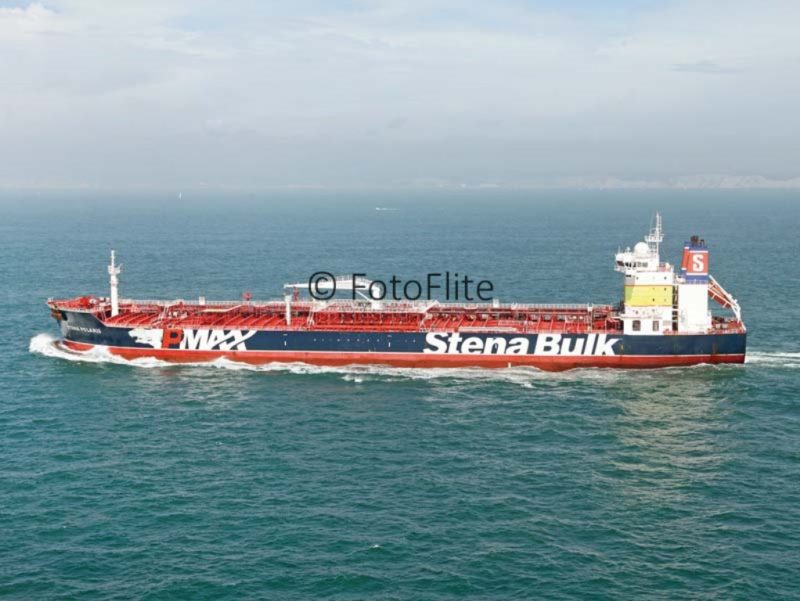
THE STENA LINE NORTH SEA AND BALTIC SEA SERVICES
During the 1980s, Stena Line acquired three other major competing ferry lines. In June 1983, its biggest competitor on the Sweden to Denmark routes was Sessan Line, which was acquired and incorporated into Stena Line, including their biggest ro-pax newbuild sisters in Kronprinsessan Victoria of 1981 (renamed Stena Saga (2) in 1988 and Stena Europe in 1994) and Prinsessan Birgitta of 1982, which became the largest ferries in the Stena Line fleet at that date. Prinsessan Birgitta became St. Nicholas of Sealink (U.K.) Ltd. for a Harwich to Hook of Holland service, replacing both St. George and Prinz Oberon, the latter chartered from DFDS. She was renamed Stena Normandy for a Southampton to Cherbourg service in June 1991, making two trips daily with accommodation for 1,600 passengers and 900 berths. She was chartered in January 1998 and sold in February 2001 to the Irish Continental Group for $21.75 million. Prinsessan Desiree also joined the Stena Line fleet but was sold off in 1983, and Prinsessan Christina was later renamed Stena Nordica and Stena Prince.
In 1983, Stena Line A/B acquired Varberg-Grenaa Line, and two years later the right also to the former name of the operating company, Lion Ferry. Lion Ferry continued as a separate marketing name within Stena Line until 1997, when it was incorporated into Stena Line. In 1989, Stena Line A/B acquired yet another ferry company in Stoomvaart Maats Zeeland (SMZ), which was trading in that year as Crown Line of Holland.
This gave Stena Line the most lucrative ferry route on the North Sea in the Hook of Holland to Harwich route, and it has been operated ever since as the only passenger ferry service on the route. Koningin Beatrix was the SMZ Ro-pax and had been built in 1986 by the Van der Giessen du Nord yard at Krimpen in Holland, and was transferred away from the North Sea in 1997 (on the advent of the HSS 1500 Stena Discovery at Harwich) to the Fishguard to Rosslare route, replacing Stena Felicity. She was transferred again in 2002 to the Karlskrona to Gydnia route as Stena Baltica, swapping routes with Stena Europe. This famous Dutch ferry is still in service today as SNAV Adriatico for Italian owners.
The Stena Line A/B fleet doubled in size on 31st May 1990 with the hostile acquisition of Sealink (U.K.) Ltd. from Sea Containers, led by James Sherwood, for £259 million. Thus, at a stroke, the Stena fleet became a major force in British as well as Scandinavian waters, with operating income then coming from the Dover to Calais, Folkestone to Boulogne, Fishguard to Rosslare, Holyhead to Dun Laoghaire, Stranraer to Larne and Harwich to Hook of Holland routes. All of the owned or chartered ships and the four ports of Harwich, Fishguard, Holyhead and Stranraer were included in the bargain price. After two changes of name, the company became in 1995 Stena Line (U.K.) Ltd., which currently operates all of the Stena Line ro-paxes and ro-ros between England, Scotland, Wales and Northern Ireland and Eire.
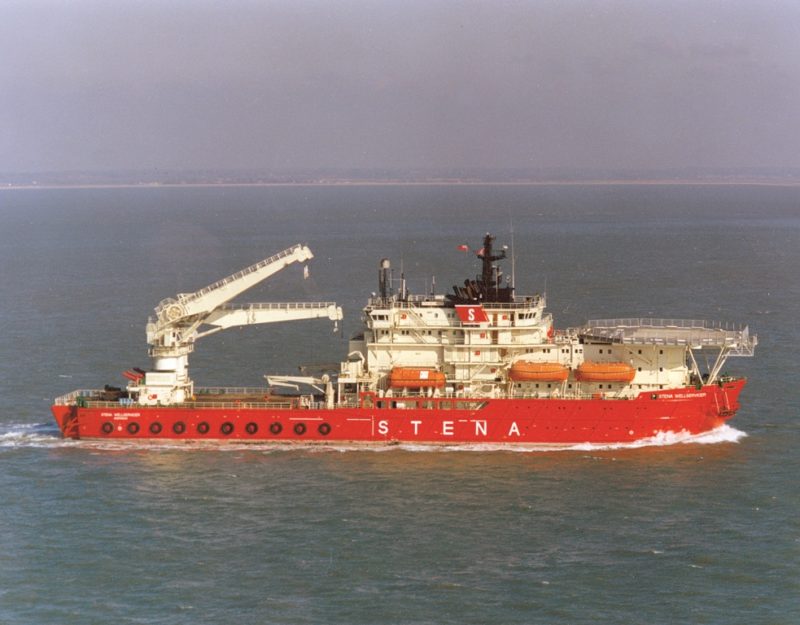
Two Ro-pax sisters, Stena Fantasia and Fiesta, were introduced on the Dover to Calais route at the end of 1990 after major rebuilds from freight ro-ros Tzarevetz and Trapezitza, built in 1980 by Kockums at Malmo for Navigation Maritime Bulgare. These rebuilds included passenger berthed accommodation for 175, as well as deck passengers, and 826 TEU of containers on trailers on the vehicle deck. Identification of this pair was very easy, as forward of the twin funnels was the domed top of a very luxurious lounge on the deck below Boat Deck. This pair were very unwieldy in at slow speeds and berthing was too slow. At the Gotaverken yard in Gothenburg, an extra propeller was added between the twin rudders and an extra bow thruster was added to enable an extra crossing per day to make five per day. Stena Fantasia switched in 1998 to P. & O. Stena Ferries as P&OSL Canterbury, while Fiesta changed to SeaFrance in 1996 as SeaFrance Cezanne.
I happened to be returning from Calais on Stena Fantasia in Stena Line colours on 4th January 1998 during a Force 10 mini typhoon which suddenly swept up Channel, and forced us to take a battering while cavorting around at slow speed in mid Channel as we rode out the storm at night. We had two passengers with bad head injuries, and were allowed into Dover before the rest of the waiting fleet to allow two green clad paramedics to jump onto the stern from the linkspan in order to treat these serious injuries.
Timing was important for the jump as there was a swell of six feet running in the harbour. Tables in the main lounge were quickly turned into treatment areas with sheets, and the paramedics managed to stem the flow of blood from bad head injuries. We then returned to mid Channel to await the time when the Port of Dover reopened a day or so later. A large amount of Portmeirion crockery and expensive electrical goods, and all of the biscuits, presents and tourist items were unceremoniously smashed on the floor of the shop during the cavorting of the ferry, making it resemble a very dangerous, sliding disaster area.

Three Highspeed Sea Service (HSS) fast craft were introduced in 1996/97 to the Stranraer to Belfast, Holyhead to Dun Laoghaire, and Harwich to Hook of Holland services as Stena Voyager, Stena Explorer and Stena Discovery respectively, each carrying 1,500 passengers. The smaller fast craft Stena Carisma, built in 1997, carried 900 passengers and operated on the Gothenburg to Frederikshavn route. Stena Empereur was the new name of Stena Jutlandica (2) of 1983, previously in Scandinavian waters, when transferred to the Dover to Calais route in 1996 with capacity for 2,300 passengers and 550 cars, the largest of any ship on this busy English Channel route.
In 1998, the Stena Line ferry operations from Dover and Newhaven to Calais, Boulogne and Dieppe were merged with P. & O. European Ferries to form P. & O. Stena Line, 40% of which was owned by Stena Line and 60% by P. & O., which then acquired all of the Stena shares four years later and changed the name to P. & O. Ferries. This new joint company was formed in response to the vigorous competition from the Channel Tunnel, completed in 1994 at the enormous cost of £12 billion. Eurotunnel slashed its fares to France through the tunnel, and decided not to pay interest on the construction costs, with the result that both Stena Line and P. & O. Ferries had suffered badly from price competition. The new company started with Stena contributing five conventional ferries, and the fast craft Stena Pegasus on the Newhaven to Dieppe route, while P. & O. Ferries contributed eight ferries running from Dover to Calais and Zeebrugge. The new company was expected to save £75 million with a staff reduction of one thousand amongst the joint 5,500 workforce. Dan Sten Olsson of Stena and Lord Sterling were joint Chairmen of the new company, with each company having four directors on the Board including Russell Peters, Managing Director of P. & O. Ferries at Dover. Gareth Cooper of Stena Line and Graeme Dunlop of P. & O. Ferries remained in charge of the other U.K. ferry businesses.
A venture that was not successful due to vested casino interests of Native Americans in British Columbia and on the border with the United States was Stena BC Line in the summer of 1990. This operated across Puget Sound from Victoria on Vancouver Island to Seattle. Lion Queen was refitted and modernised with a casino and renamed Crown Princess Victoria to run alongside two elderly small liners, the twin funnelled steamer Princess Marguerite of 1948 and the diesel powered Vancouver Island Princess of 1955. However, the arrival in British Columbian waters of a North European built ferry in opposition to State owned ferries was greeted with an immediate large tax bill, that was only nullified by the intervention of the Federal Canadian Government in Ottawa. The competing floating casino on the Stena ferry provoked strenuous and vociferous opposition from the Native Americans, whose way of life was based on shore based casinos, and the Stena BC Line venture was very quickly ended.
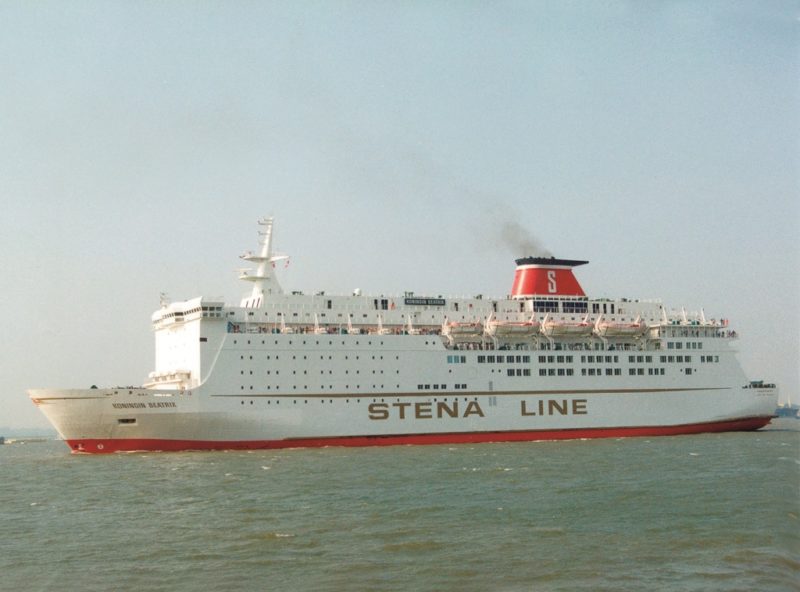
The new classes of ro-paxes and ro-ros that had entered Stena Line service during the period from 1980 to 2000 were as follows:-
Stena Danica (4) and Stena Jutlandica (2) were two larger jumbo sized ro-paxes of 28,727 grt built at Dunkirk by Chantiers du Nord de la Mediterranee and designed by consulting naval architects Knud E. Hansen A/S, who also designed many other classes of Stena ro-paxes and ro-ros. The pair were very impressive in the interior decorations of their lounges and restaurants, and Stena began an intensive marketing campaign before their arrival in service in 1983 on the Gothenburg to Frederikshavn route, taking three hours 15 minutes for the voyage. They carried a blue painted disc on their white hulls forward of the logo ‘STENA LINE’ with the words ‘Levande Kattegat’ to promote clean seas and environmental protection on their route. They had an overall length of 154.9 metres, service speeds of 19.5 knots, and could accommodate 2,274 passengers, with 120 trailers with containers, and 550 cars on their vehicle decks. Stena Jutlandica (2) was renamed Stena Empereur for Dover to Calais service in 1996.
Stena Germanica and Stena Scandinavica were two more large jumbo sized ferries of 38,772 grt completed in Polish yards in 1987/88, after delays caused by the labour strikes of the Solidarity freedom movement of that period. They had an overall length of 175.4 metres, service speeds of 20.0 knots, and could accommodate 2,400 passengers with 120 trailers with containers and 550 cars on their vehicle decks. They were built for the Gothenburg to Kiel route, taking 14 hours for the voyage, and during the summer season on some days the vessel arriving in Gothenburg overnight would make a daylight round trip to Frederikshavn before departing to Kiel on the following evening. During the winter of 1998/99 they were modified to increase freight capacity and reduce the number of cabins. After the arrival of this pair in service in 1987/88, Stena Saga (2), the former Kronprinsessan Victoria built in 1981, was transferred to the Oslo to Frederikshavn service. In 1994, she was then transferred to the Harwich to Hook of Holland service as Stena Europe.
Silvia Regina was built in 1981 by the Wartsila yard in Finland for Silja Line service between Stockholm and Helsinki with luxurious capacity for 2,000 passengers and a lane length of 1,610 metres for trucks and 510 cars. She has dimensions of overall length of 166.5 metres, moulded beam of 28.5 metres, and a loaded draft of 6.71 metres, with a good service speed of 22 knots from a quartet of Wartsila Pielstick 12PC25V diesel engines. She was purchased by Stena Line in 1991 and renamed Stena Britannica (2) for the Harwich to Hook service on arrival at the Hook of Holland on 17th June 1991 to partner Koningin Beatrix. The Harwich to Hook of Holland service celebrated its centenary on 1st June 1993, and both Stena Britannica (2) and Koningin Beatrix had a special large diameter logo painted on their hulls with the celebratory ‘100 Years’. In March 1994, Stena Britannica (2) was renamed Stena Saga (3) for the Oslo to Frederikshavn service in an exchange of route with Stena Saga (2). She is currently laid up at Uddevalla in Sweden as Saga.
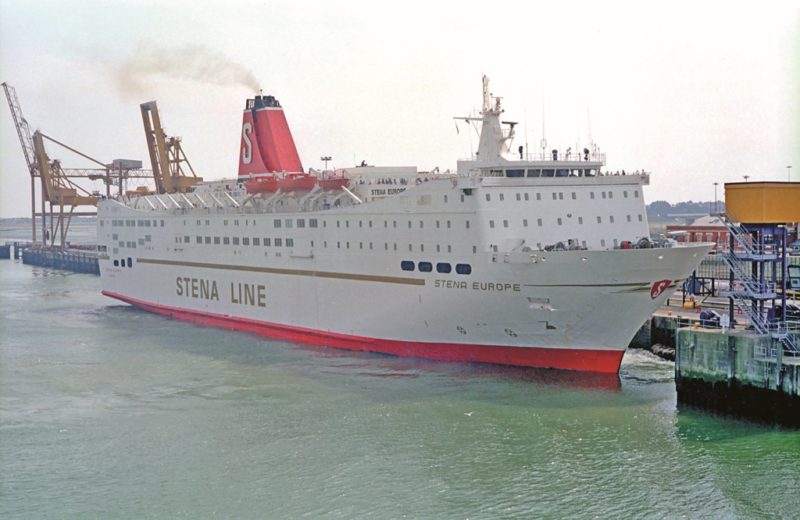
THE STENA IRISH SEA SERVICES
Sealink (U.K.) Ltd. was formed on 1st January 1979, however the trade group name of ‘SEALINK’ had been used on the hulls of British Rail ferries since 1972/73 as well as on the ferries of their French, Belgian and Dutch partners. In April of that year the chartered Stena Normandica with capacity for 450 cars replaced Avalon on the summer schedule from Fishguard to Rosslare. This sharp increase in car capacity led to the start of a major car touring holiday industry in the South and South West of Ireland. The British & Irish Steam Packet Co. Ltd., established in 1836 but at that time State owned, opened a rival Pembroke Dock to Rosslare service in May 1980 using the chartered Viking III.
The newly opened central pier and ro-ro ramp at Rosslare was used for this Pembroke Dock service, which was operated from October 1980 by Stena Nordica, an exact sister of Stena Normandica. During refits of Stena Normandica, three of the four new Harland & Wolff built ferries, St. David, St. Christopher and St. Anselm, deputised on the route and included a long period of several months in Spring 1984 when Stena Normandica received a £0.5 million refit to bring her up to Sealink standard, at the conclusion of which she was renamed St. Brendan. The venerable saint had in antiquity made spectacular sea voyages from Ireland to as far away as Madeira. Subsequently, refits of St. Brendan were covered by the Folkes-tone trio of Horsa, Hengist and Senlac and the Tyne built Vortigern completed in 1969.
In summer 1987, the Sealink service to South Wales was run on a joint basis with the B. & I. Line service to cut costs, with the hull wording on both services as ‘B & I Line ROSSLARE-FISHGUARD Sealink’, and the funnels had a joint logo. On 31st May 1990, Stena Line purchased Sealink for $259 million, including the larger ferry Felicity with capacity for 517 cars and 1,142 passenger berths and 872 deck passengers, which had been on charter for the Rosslare to Fishguard service from September 1989. She had replaced St. Brendan in March 1980 and then underwent a major refit at Tilbury at the conclusion of which she was renamed Stena Felicity. She offered a new standard of comfort and luxury on the Rosslare to Fishguard route, which she operated for seven years.
Stena Felicity was replaced in 1997 on the Rosslare to Fishguard service of Stena Line by Koningin Beatrix, completed for the Zeeland Steamship Company (SMZ) of Holland in 1986 by the Van der Giessen yard at Krimpen with accommodation for 2,100 passengers, until 2002. Stena Europe then took over the route, she had been completed in 1981 as Kronprinsessan Victoria for Swedish owners with capacity for 2,076 passengers in berthed and unberthed accommodation and 456 cars. Stena Europe made two crossings daily to Fishguard, each taking three hours and 30 minutes at her service speed of 21 knots from quadruple 12-cylinder Wartsila diesels of 20,600 bhp. A fast ferry also operated on the route in summer only for Stena Line, cutting the crossing time down to only one hour and fifty minutes, marketed as Stena Express.
The Irish Ferries service from Rosslare to Cherbourg and Le Havre ran until January 1998 when the larger Stena Normandy of 17,043 grt and capacity for 2,100 passengers and 460 cars was renamed as Normandy on charter on the route. She was a sister of Stena Europe and had been built in 1981 by the Arendal yard at Gothenburg as Prinsessan Birgitta, and had later sailed as St. Nicholas for Sealink on the Harwich to Hook of Holland service, and was well known on the Southampton to Cherbourg route as Stena Normandy. One of her distinctive features was her staggered windows aft of her tiered show lounge, a feature also incorporated on her near identical sister of Stena Europe. The exterior of the two ferries was identical, however Stena Europe had seventy cabins more than her sister. Normandy was laid up by Irish Ferries in November 2007 after difficulties had arisen, and after use as an accommodation ship at the Sembawang yard in Singapore she sailed for Alang from Singa-pore on 31st October 2012 for breaking up.
Stena Line acquired the Celtic Link ferry service from Rosslare to Cherbourg in an announcement on 26th February 2014, and began using the chartered in ‘Visentini’ type Stena Horizon (ex Celtic Horizon) from 1st April 2014 on three weekly sailings on the route. Stena Europe was almost on her beam ends on 31st January 2015 when entering Fishguard harbour in heavy weather, leading to a freight trailer overturning and preventing the disembarkation of all vehicle traffic due to the ferry berthing stern first. All foot passengers were safely disembarked and the ferry went back to sea until the weather moderated to allow her to berth bow first. The current Stena Line ferries operating in 2021 from Rosslare are Stena Europe on the Fishguard service, with the new Ro-pax Stena Embla and the chartered in Ro-pax Stena Horizon on the Rosslare to Cherbourg, with freight ro-ro Stena Foreteller operating with this latter pair as freight only.
When the HSS 1500 Stena Explorer began on the Holyhead to Dun Laoghaire in 1996, the service was supplemented by Stena Hibernia, the former St. Columba, built by Aalborg Vaerft in 1977 to accommodate 1,700 passengers with 335 cars on her car deck on the twice daily Holyhead to Dun Laoghaire service. St. Columba had been on the route when it was taken over by Stena Line in 1990. Stena Hibernia was renamed Stena Adventurer in 1996 for an extra year on her familiar route until she was sold to Agapitos Express Ferries of Greece and renamed Express Aphrodite.
Stena Challenger of 18,523 grt, built by Fosen of Norway in 1991 to accommodate 500 passengers and 480 cars on her car deck of lane length 1,468 metres, initially served on the Dover to Calais route until moved to the Holyhead to Dublin service between 1996 and 2001. Stena Traveller, sister of Stena Challenger from the same Fosen yard, also served for two spells on the Holyhead to Dublin service. The ‘Visentini’ type Stena Forwarder was then chartered for a two year period from 2001 to 2003, until the new Stena Adventurer (2) was ready at the Hyundai Heavy Industries yard in South Korea. She is of 43,532 grt and can accommodate 1,500 passengers with 500 cars on her car deck of lane length 3,400 metres. Stena Superfast X was chartered in 2015 for five years and ran with Stena Adventurer (2) from Holyhead until displaced by the new ‘E Flexer’ Stena Estrid. Stena Line announced the withdrawal of the Dun Laoghaire link with Holyhead in February 2015 after nearly 190 years of the connection between the two ports, Dublin being used henceforth.
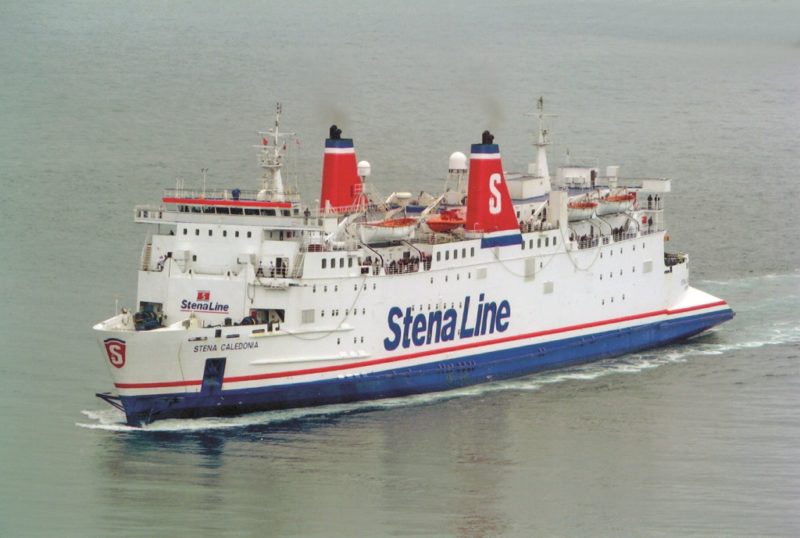
The Stranraer to Larne service was transferred on 13th November 1995 to a Stranraer to Belfast service. Stena Line reduced the time on voyage passage on its Belfast to Stranraer route in May 2008 by ten minutes by switching berths from Albert Quay in Belfast to the new Victoria Terminal 4. An extra ship and formerly in the fleet as Stena Parisien was repurchased in July 2009 from SeaFrance for the Stranraer service and was renamed as Stena Navigator, to run alongside the wide hulled HSS 1500 Stena Voyager and the conventional ferry Stena Caledonia. However, all three moved on for further service or breaking up when the Stranraer terminal was closed in 2011. Two long term chartered ‘Superfast’ ferries from the Estonian ferry operator Tallink were introduced on the new Stena terminal at Cairnryan as Superfast VII and Superfast VIII on 21st November 2011. They underwent refits in Poland to change them from overnight ferries to the short three hour day run from Cairnryan, which included the demolition of an entire deck of cabins to be replaced by public rooms, with other changes to the vehicle decks and with new more efficient propellers fitted. Stena Superfast VII suffered minor technical difficulties in mid August 2015 resulting in her missing a round trip on the Cairnryan to Belfast route.
Stena Line also announced in December 2010 that it had acquired the Northern Irish Sea operations of DFDS Seaways. The sale included the Belfast to Heysham and Birkenhead routes, plus two ferries on the Heysham route in Scotia Seaways and Hibernia Seaways, and two chartered ferries from the Birkenhead to Belfast route in Mersey Seaways and Lagan Seaways. The long running freight ferry route from Fleetwood to Larne using three former P. & O. freight ferries, Stena Leader, Stena Pioneer and Stena Seafarer, was closed down on Christmas Eve 2010.
Seatruck Precision and Seatruck Performer, built for Seatruck Ferries by Flensburger Schiffs Gesellschaft (FSG) in 2010 for the Belfast to Heysham route, were chartered by Stena Line from September 2012 to the end of August 2018. They replaced Stena Hibernia and Stena Scotia, which had less freight capacity, and were renamed Stena Precision and Stena Performer. Stena Hibernia later swapped routes with Stena Precision to increase capacity on the Belfast to Birkenhead route alongside Stena Lagan and Stena Mersey as the third ship on this run.
The ‘Visentini’ type ferries Stena Lagan and Stena Mersey, built in 2005, left Liverpool to Belfast service in 2021 for refits in Turkey where they were fitted with 36 metre mid-sections to add a further 30% capacity to their passenger and freight loadings. They are renamed Stena Scandica and Stena Baltica respectively after their refits and take up the new Stockholm South (Norvik) to Ventspils route. Their new increased capacity will be 970 passengers with 200 new cabins fitted, lane length of 2,875 metres plus an additional car deck.

CONTINUED NEXT MONTH
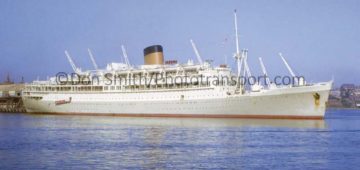


Comments
Sorry, comments are closed for this item